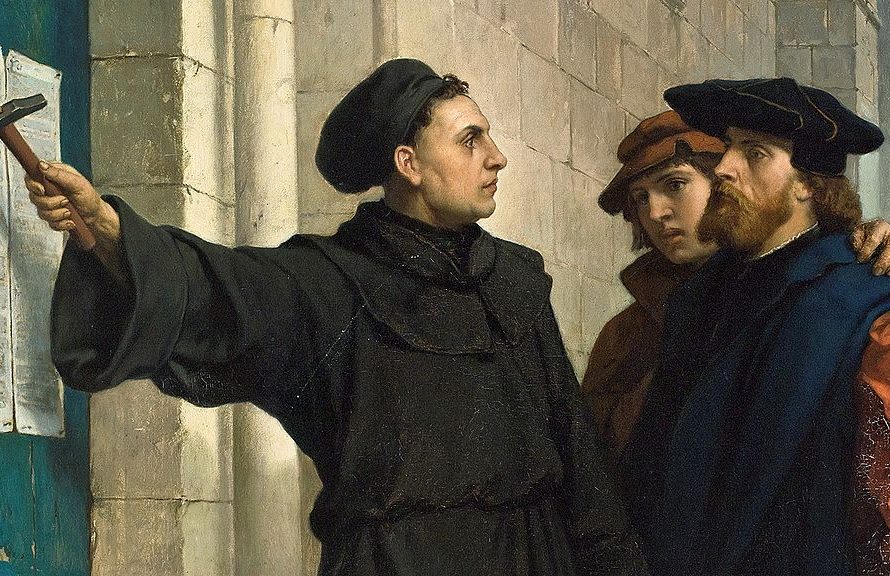“For the end of the world was long ago,
When ends of the world waxed free ….”
– G.K. Chesterton, “The Ballad of the White Horse”
* * *
“On a sultry day in July of the year 1505 a lonely traveler was trudging over a parched road on the outskirts of the Saxon village of Stotternheim. He was a young man, short but sturdy, and wore the dress of a university student. As he approached the village, the sky became overcast. Suddenly there was a shower, then a crashing storm. A bolt of lightning rived the gloom and knocked the man to the ground. Struggling to rise, he cried in terror, ‘St. Anne, help me! I will become a monk.’
“The man who thus called upon a saint was later to repudiate the cult of the saints. He who vowed to become a monk was later to renounce monasticism. A loyal son of the Catholic Church, he was later to shatter the structure of medieval Catholicism. A devoted servant of the pope, he was later to identify the popes with Antichrist. For this young man was Martin Luther.”
With these words, Reformation historian Roland Bainton began his classic biography, Here I Stand: A Life of Martin Luther. As Bainton recounts, Luther’s encounter with a thunderbolt sent the young man to the monastery. But why? After all, we wouldn’t imagine that, in the same scenario, a 21st-century secularist from New York would respond as the young Luther had.
Luther’s response to the thunderbolt was telling. It revealed his beliefs and deepest fears. For, as Bainton himself says, Luther was a medieval man. His parents taught him early in life to fear devils in the outhouse and—due to vestiges of German paganism in their thought—to fear elves, sprites and witches in the woods. More than anything, however, he feared the imminent day of doom at the end of the world, when the Lord Jesus Christ in majesty would judge the quick and the dead.
“It is not just the old Luther who sees the world coming to an end; already the young Luther has seen that the world has grown old,” another famed Reformation historian, Heiko Oberman, writes. Like many medieval men and women, Luther did not see himself as living in a Middle Age. Rather, he saw himself as living at the end of all ages.
Indeed, the idea that the Middle Ages was, well, “somewhere in the middle” was not the typical assumption of medieval men and women. Instead, this idea derived from people who saw themselves as having recovered a glorious past that had for some time been lost: According to the champions of the Renaissance and Enlightenment, the grand knowledge and artistry of ancient Greece and Rome had finally been reborn after being wrapped in barbarian darkness for a thousand years; according to heirs of the Reformation, the purity of early Christianity had finally been rediscovered and the gospel had dawned after a dark age.
But more recent thinkers have questioned this view of the Middle Ages. In fact, while speaking at his 1954 inaugural lecture as the Chair of Medieval and Renaissance Studies at Cambridge University, the renowned Christian author C.S. Lewis denounced the claim that Modern man had “scrambled ashore out of the great, dark surging sea of the Middle Ages.”
And, in a sense, he was right. The Middle Ages wasn’t as “in the middle” or as “dark” as we often take it to be. After all, this time period—which runs roughly from 500 A.D. to 1500 A.D.—has given us much to be thankful for: For example, books replaced scrolls; universities were founded; biblical concordances were invented; scholars first formulated arguments for God’s existence that are still used today by men and women defending Christianity. And, of course, the Middle Ages gave us Martin Luther. For, had not a thunderbolt knocked him into the monastery, he never would have broken out of monasticism to become a Reformer.
But, of course, this begs the question: If the Middle Ages was so great, why all Luther’s fuss about Reformation? Here again, we find roots in the Middle Ages for the very idea of “Reformation.” After all, however wrong-headed they were, monasteries were started to preserve a purer devotion to Christ and his commands. And even various medieval popes and councils called for the church to be reformed in both root and branch. This is no wonder, since—during the 1300s—two and then three competing popes had at one and the same time claimed sole authority over the church in Western Europe.
Something was definitely amiss. Even if the Middle Ages weren’t as dark as we often imagine, the medieval church had serious problems—and no one doubted it. But looking at the problems through the lens of his own study of Scripture, Luther would say that monastic and other medieval reform efforts had missed the mark. He insisted that no moral stricture, no pious effort, no institutional renovation would fix these issues. Medieval men and women, like those in our own age, must rather return to the truth of the gospel—namely, that Christ is all in all, and he is found and grasped by faith alone.
Now, there was a medieval cry for reform that, in some ways, foreshadowed Luther’s own call for Reformation. Indeed, it presaged, if not the end of all ages, at least the end of the world as the young man Luther and his contemporaries had known it. It is this “morning star” of the Protestant Reformation that we’ll consider in the next issue of The Pathway.

